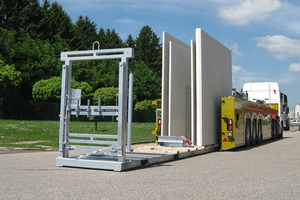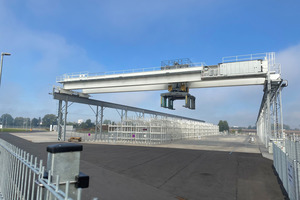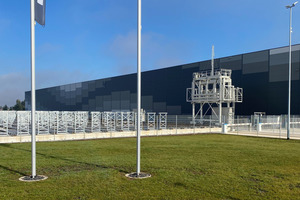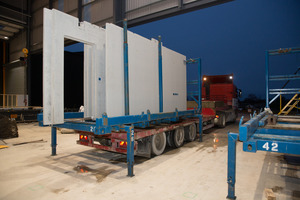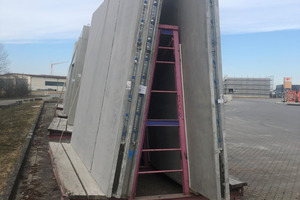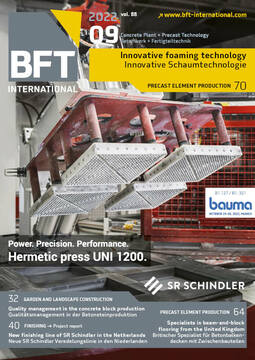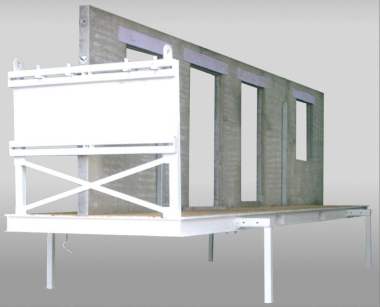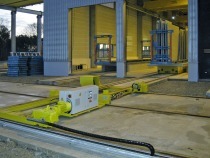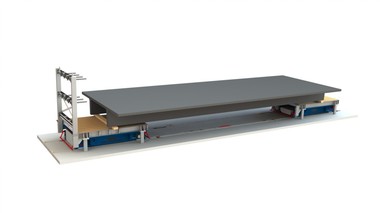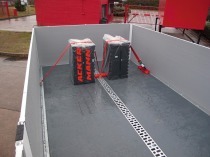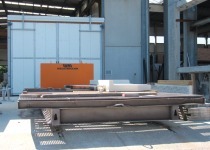Handling precast walls and floor slabs with ease: Software-controlled transport systems ensure greater storage efficiency
In recent years, great advances have been made in automating the production of large-sized precast elements such as wall panels and floor slabs. Many manufacturers are struggling with the same problems, namely too little storage space and a high amount of labor required for intralogistics. Given this situation, Weckenmann developed highly efficient transport systems that can also be tailored to specific customer needs. They take care of the transfer and storage of precast elements in a software-controlled, automated process, and thus also represent the state of the art of optimized precast product handling.
Transport system for stackable racks
The transport system for stackable racks is, according to the supplier, the perfect choice for customers who wish to eliminate the need for transport pallets when loading trucks while wanting to increase their storage capacity depending on the stacking height. Developing this solution was based on the idea that precast floor slabs are usually delivered to the construction site stacked in a horizontal position on transport pallets. Alternatively, they would be loaded directly onto the truck, thus dispensing with the return of the pallets. The biggest challenge is the maneuvering of trucks and pallets, which ties up material and human resources.
The fully automated Weckenmann transport system solves this problem: It is operated in a software-controlled process and implements chaotic storage by automated transfer of full and empty racks. The generous equipment specifications include performance reserves to ensure maximum flexibility. Manual control by a single operator is very easy.
More efficient utilization of storage space
The new transport system allows for storage space to be utilized more efficiently. Each rack holds one stack of floor slabs, and four racks can be stacked upon each other, for example. Loading is carried out by a crane according to a logical stacking sequence specified by the master computer.
In the next step, a lift truck or transfer platform moves the occupied racks consisting of steel frames with stacking bases to the cordoned-off storage area, where a fully automatic bridge crane equipped with a specially designed crossbeam operates. Combined with a number of sensors, this innovative mechanical system ensures the safe storage and retrieval of the racks, which can be challenging particularly in difficult weather conditions and strong winds. The new system will make this work step much easier.
Storage management software facilitates restacking
Once the stacks of floor slabs are ready for being loaded onto the truck, the automatic crane moves the appropriate rack to the loading zone. Storage management software facilitates any necessary restacking of the racks via so-called get/fetch orders issued to the crane. The crane’s own control system then ensures automated crane and crossbeam movements. The truck driver takes over the crane operation via a radio remote control from a certain transfer position in order to remove the stack of floor slabs from the rack by manual operation. Flexible arms mounted on the crane crossbeam make it easier to reach under stacks of different widths and lengths. The horizontally rotatable crossbeam allows for precise alignment of the slab stack on the truck. Once loading is complete, the crane switches back to automatic mode.
Loading and unloading without crane
Transporting large-sized precast elements to the construction site using inloader racks comes with a number of advantages, including the fact that the truck trailer itself is used for loading and unloading, eliminating the need for a crane. At a vehicle height of 4 m, the elements can be up to 3.7 m high. Precast elements can be removed as required by the assembly sequence. Prior to transport to the job site, the inloader racks are loaded in the factory building in accordance with project and site requirements. They are then moved out of the building by means of a lift truck, and a transfer platform conveys them to the cordoned-off outdoor storage area. One or more battery-powered shuttle vehicles, which are one of the centerpieces of the transport system, fetch the racks and move them to free storage locations. These shuttles lift the load to such a height that occupied storage positions can be passed over. This approach offers the highest possible flexibility while maximizing storage area utilization, particularly in the case of tightly arranged racks.
The shuttle vehicles move to loading bays fully automatically in order to allow for the dispatch of the inloader racks to the job site. The storage management software provides an overview that indicates the position of each rack and its load. Depending on the requirements specified by the dispatch supervisor, the tool assigns the appropriate loading bay to the collector. As soon as the shuttle has unloaded the rack there, a safety barrier opens and releases this area for the truck to enter. After returning from the construction site, the empty racks are fed back into the cycle via a roller conveyor. They can then either be deposited in the storage area or transported directly to the loading zone forming part of the production line.
The above transport solution was designed and engineered to ensure 100% functionality even in wind, rain, snow and fog.
Customized solutions
Customers can optimize the utilization of their storage capacity by using a transport system, which can also be tailored to their specific needs. Energy is supplied by powerful batteries designed for high speed and performance. Thanks to the software-controlled transport solution developed by Weckenmann, chaotic storage of full and empty racks of all types is intuitive and saves labor and resources.
CONTACT
Weckenmann Anlagentechnik GmbH & Co. KG
Birkenstraße 1
72358 Dormettingen/Germany
+49 7427 9493-0

